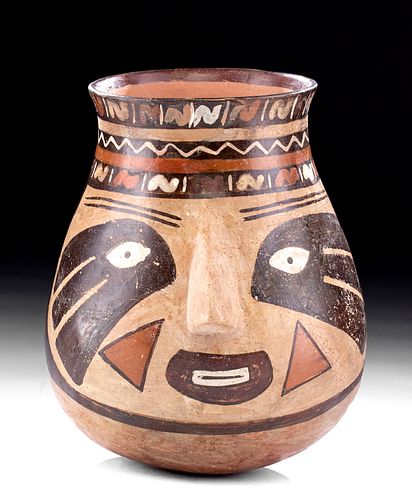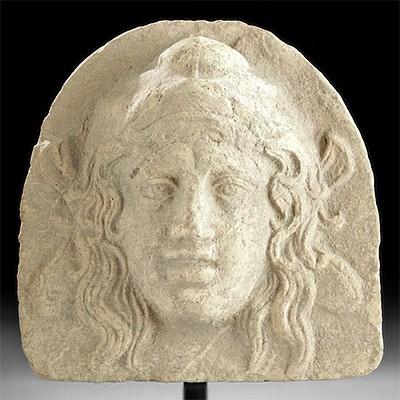Large Nazca Polychrome Portrait Vessel
Lot 134a
About Seller
Artemis Fine Arts
686 S Taylor Ave, Ste 106
Louisville, CO 80027
United States
Selling antiquities, ancient and ethnographic art online since 1993, Artemis Gallery specializes in Classical Antiquities (Egyptian, Greek, Roman, Near Eastern), Asian, Pre-Columbian, African / Tribal / Oceanographic art. Our extensive inventory includes pottery, stone, metal, wood, glass and textil...Read more
Estimate:
$1,800 - $2,500
Absentee vs Live bid
Two ways to bid:
- Leave a max absentee bid and the platform will bid on your behalf up to your maximum bid during the live auction.
- Bid live during the auction and your bids will be submitted real-time to the auctioneer.
Bid Increments
| Price | Bid Increment |
|---|---|
| $0 | $25 |
| $300 | $50 |
| $1,000 | $100 |
| $2,000 | $250 |
| $5,000 | $500 |
| $10,000 | $1,000 |
| $20,000 | $2,500 |
| $50,000 | $5,000 |
| $100,000 | $10,000 |
| $200,000 | $20,000 |
About Auction
By Artemis Fine Arts
Feb 27, 2020
Set Reminder
2020-02-27 10:00:00
2020-02-27 10:00:00
America/New_York
Bidsquare
Bidsquare : VARIETY SALE | Antiquities & Ethnographic Art
https://www.bidsquare.com/auctions/artemis-gallery/variety-sale-antiquities-ethnographic-art-4920
Around the world & back in time - be amazed at the treasures you will find. Antiquities from Egypt, Greece, Italy and the Near East, Asian, Pre-Columbian, African / Tribal / Oceanic, Native American, Spanish Colonial, Russian Icons, Fine Art, much more! Artemis Fine Arts info@artemisfinearts.com
Around the world & back in time - be amazed at the treasures you will find. Antiquities from Egypt, Greece, Italy and the Near East, Asian, Pre-Columbian, African / Tribal / Oceanic, Native American, Spanish Colonial, Russian Icons, Fine Art, much more! Artemis Fine Arts info@artemisfinearts.com
- Lot Description
Pre-Columbian, South Coast Peru, Nazca, ca. 200 to 500 CE. A wonderful pottery vessel with a round but stable base, a broad body that tapers to form the corseted neck, and a flared rim surrounding the deep interior cavity. The exterior surfaces are highly burnished and provide a smooth ground atop which a highly stylized, disembodied trophy head is illustrated. The expressive countenance bears white, almond-shaped eyes within black facial streaks, a triangular nose in high relief, full lips flanked with triangular facial scars, and a pair of bifurcated eyebrows. The forehead is lined with a pair of Z-filled headbands that enclose a brown-and-white zigzagging headband. A neatly illustrated example of fine Nazca artistry! Lucite display stand for photography purposes only. Size: 5.5" W x 6.8" H (14 cm x 17.3 cm)
In the Nazca culture and other ancient Peruvian cultures, the decapitation and ritual use of human heads was common practice. Various pieces of pottery and painted art depicting mythical figures and kings holding trophy heads or in the presence of trophy heads have been unearthed at Nazca archaeological sites. This vessel, showing an unassociated trophy head with no one holding it, is a style of depiction common only to Nazca art. Archaeological evidence from the 20th century shows that these stylized paintings are based on real rituals - over one hundred mummified trophy heads have been found from Nazca excavations, almost all with a puncture to the front of the skull for suspension.
Provenance: ex-private Hans Juergen Westermann collection, Germany, acquired in the 1950s to 1960s
All items legal to buy/sell under U.S. Statute covering cultural patrimony Code 2600, CHAPTER 14, and are guaranteed to be as described or your money back.
A Certificate of Authenticity will accompany all winning bids.
We ship worldwide and handle all shipping in-house for your convenience.
#150506Professionally repaired from multiple pieces, with restoration to nose and along some areas of body, neck, and rim, and resurfacing with overpainting along new material and break lines. Abrasions and minor pitting to base, body, neck, rim, and interior, with fading and touch-up painting to some areas of original pigment. Light earthen deposits and traces of original pigment throughout. Old inventory label beneath base.Condition
- Shipping Info
-
All shipping is handled in-house for your convenience. Your invoice from Artemis Gallery will include shipping calculation instructions. If in doubt, please inquire BEFORE bidding for estimated shipping costs for individual items.
-
- Buyer's Premium



 EUR
EUR CAD
CAD AUD
AUD GBP
GBP MXN
MXN HKD
HKD CNY
CNY MYR
MYR SEK
SEK SGD
SGD CHF
CHF THB
THB













